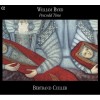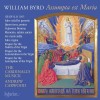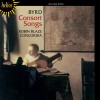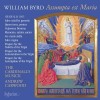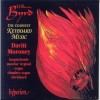Composers
Byrd was the leading English composer of his generation, and together with his continental colleagues Giovanni Palestrina (c.1525-1594) and Orlando de Lassus (1532-1594), one of the acknowledged great masters of the late Renaissance. Byrd is considered by many the greatest English composer of any age, and indeed his substantial volume of high quality compositions in every genre of the time makes it easy to consider him the greatest composer of the Renaissance – his versatility and genius outshining those of Palestrina and Lassus in a self-evident way. English music of the period was amazingly rich, dominating the music of the continent in depth and variety, in a way that was not seen before or since. Also, Byrd's pre-eminent position at the beginning of music publication in England allowed him to leave a substantial printed legacy at the inception of many important musical forms. It would be impossible to over-estimate his subsequent influence on the music of England, the Low Countries, and Germany.
Byrd was probably born in Lincoln where he took up the post of organist at an early age. Later he accepted a position in the Royal Chapel of Queen Elizabeth, and retired at the age of fifty to a home at Stondon Massey near the Essex estate of one of his richest patrons, Sir John Petre. Byrd was a Catholic in Protestant England, and though this position demanded a certain amount of seclusion and discretion, his loyalty to the Crown was never in doubt. Indeed, Byrd continued to enjoy the favor of the Queen, as well as continuation of his privilege as sole holder of the publishing monopoly which had been awarded jointly to Byrd and Thomas Tallis (his teacher) before the latter's death. Byrd was able to publish Latin sacred music throughout his life, though opportunities for public performance in a liturgical setting would not have existed. These pieces were apparently performed in private residences, either as Latin songs in a setting similar to that of secular music, or at secret Catholic religious services. In either case, Byrd's Latin works were well-known during his lifetime, and continue to be the most widely performed of his compositions.
Byrd also contributed heavily to the developing genre of the English Anthem (including the newer "verse" style with organ accompaniment), composing his widely regarded "Great Service" in this format. However, it was his Latin music that he chose to publish. This was series inaugurated in 1575 with the volume of "Cantiones Sacrae," a joint collection with Thomas Tallis. Though this publication was not especially successful, Byrd followed it up with two more: the "Cantiones Sacrae" of 1589 & 1591. These "sacred songs" would be called motets on the continent, and represent the most significant English contribution to the motet repertory. The motets are almost exclusively for five-voice vocal ensembles, with the most varied counterpoint and text selections. Though these texts are all sacred in origin, many of them have political implications, illustrating Byrd's fringe position as a Catholic composer. Some of these motets are much more popular than others, but all are of uniformly high quality, showing Byrd's predilection for precisely controlled counterpoint put to the service of the syllabic expression of text.
Byrd also composed three Latin Masses (for three, four, and five voices) during the period 1593-1595. These masses are unusual not only because they could no longer have a liturgical function, but also because they include settings of the "Kyrie" – something not previously done in English mass composition. The masses show Byrd in a reflective mode: it would seem that he composed these cycles as exercises, as easily performable functional music, and as historical examples. Though they are straightforward in design, the masses possess a "classical" quality of precision and balance. Their simple expression and contrapuntal concision make them unique in Renaissance music, and early examples of the classical spirit which was to dominate Europe two hundred years after Byrd's time.
Following the three masses, Byrd produced his unparalled legacy in sacred choral composition the two huge volumes of "Gradualia" (1605 & 1607). These publications consist of many short pieces of liturgical music, set in verse sections, which can be combined in various ways to form liturgically accurate Propers cycles for every significant feast and votive mass of the Roman Catholic Rite. Technically, this achievement is immense – it involves setting every possible Propers verse with the appropriate chant melody, and then providing instructions for assembling each of the cycles from the relevant verses. Byrd's invigoration by formal demands is clearly in evidence here, as well as his keen intellect in devising these pieces to fit together in such a manner. Though most of us cannot appreciate their liturgical design, the concision and clarity of the short pieces making up these books of Gradualia are impressive. These publications comprise one of the supreme testaments in Western music.
Byrd also published numerous smaller scale songs: "Psalmes, Sonets & Songs" (1588), "Songs of Sundrie Natures" (1589) & "Psalmes, Songs & Sonnets" (1611). As their titles indicate, these collections contain songs in a variety of genres, from sacred to English secular. These pieces were published with text underlays to each part, as was the fashion at the time, but Byrd also indicates that they can be performed with a single singer with viol consort accompaniment – a specifically English practice. Many of these songs continue to be extremely popular, straight through from the time of their inception to today. Byrd also composed a fairly substantial volume of consort music: viol fantasias, variations and dances of three to six parts, five five-part "In Nomines," as well as having some of his works arranged by others for the lute. Though not as singularly impressive and influential as many of his other compositional endeavors, these works are of high quality, in keeping with Byrd's versatile genius. The finest examples are the six-part consorts, including a late pavan & galliard.
The final – and perhaps most impressive – examples of Byrd's immense legacy of compositions are his keyboard pieces. Most of these were unpublished during his lifetime (due to the technical demands of keyboard engraving), but Byrd saw fit to compile a collection of some of his best music to date in 1591: "My Ladye Nevells Book." In addition, a few of Byrd's keyboard compositions were published along with some of John Bull's and Orlando Gibbons' in the first English publication of keyboard music, "Parthenia" in 1612/13. Though precise instruments were seldom specified at the time, most of Byrd's keyboard music sounds most idiomatic on the virginal/harpsichord, a lesser volume on the organ (his own instrument). This music apparently had a lively tradition of home performance, as witnessed by Byrd's compilation for his patron/pupil Lady Nevell as well as evidence that such a high figure as Queen Mary learned to play the virginal. Byrd's compositions include all the major genres of the time: the austere fantasia, the rhythmically advanced pavan & galliard pair, and the virtuosic variation set.
Byrd's keyboard music is the earliest substantial legacy in Western music, making him the first genius of the keyboard. These pieces show a substantial development of style, from the more polyphonically oriented counterpoint of the earlier works to the demanding and idiomatic keyboard writing of the later works. The early music begins as an impressive example of melodically engaging keyboard writing, and slowly develops into the later music of involved formal investigation, rhythmic ingenuity, and – ultimately – transfiguration. In the later years of his life, Byrd increasingly took up writing pieces in the paired dance forms of Pavan & Galliard; his series of works in this genre bear witness to his compositional virtuosity as convincingly as the comparable keyboard cycles of J. S. Bach's Preludes & Fugues and Beethoven's Sonatas. His most impressive pieces in this form include the "Passing Measures Pavan & Galliard" and the "Quadran Pavan & Galliard," each superimposing a strict variation structure on these serious dance forms. The formal demands Byrd sets for himself in these works are enormous, and the verve and depth with which he carries them off is as incredible as any piece of Western instrumental writing.
Taken together, Byrd's huge legacy of music – several hundred individual compositions – makes him one of the most brilliant composers in Western history. His vocal music has retained its popularity from his own time directly into ours, and his other music is now growing in appreciation as it is rediscovered. In particular, Byrd's position in the history of keyboard music is once again assured, and his contribution to the development of the North German virtuoso style is now firmly established.
Recently Added
Biography
Byrd was the leading English composer of his generation, and together with his continental colleagues Giovanni Palestrina (c.1525-1594) and Orlando de Lassus (1532-1594), one of the acknowledged great masters of the late Renaissance. Byrd is considered by many the greatest English composer of any age, and indeed his substantial volume of high quality compositions in every genre of the time makes it easy to consider him the greatest composer of the Renaissance – his versatility and genius outshining those of Palestrina and Lassus in a self-evident way. English music of the period was amazingly rich, dominating the music of the continent in depth and variety, in a way that was not seen before or since. Also, Byrd's pre-eminent position at the beginning of music publication in England allowed him to leave a substantial printed legacy at the inception of many important musical forms. It would be impossible to over-estimate his subsequent influence on the music of England, the Low Countries, and Germany.
Byrd was probably born in Lincoln where he took up the post of organist at an early age. Later he accepted a position in the Royal Chapel of Queen Elizabeth, and retired at the age of fifty to a home at Stondon Massey near the Essex estate of one of his richest patrons, Sir John Petre. Byrd was a Catholic in Protestant England, and though this position demanded a certain amount of seclusion and discretion, his loyalty to the Crown was never in doubt. Indeed, Byrd continued to enjoy the favor of the Queen, as well as continuation of his privilege as sole holder of the publishing monopoly which had been awarded jointly to Byrd and Thomas Tallis (his teacher) before the latter's death. Byrd was able to publish Latin sacred music throughout his life, though opportunities for public performance in a liturgical setting would not have existed. These pieces were apparently performed in private residences, either as Latin songs in a setting similar to that of secular music, or at secret Catholic religious services. In either case, Byrd's Latin works were well-known during his lifetime, and continue to be the most widely performed of his compositions.
Byrd also contributed heavily to the developing genre of the English Anthem (including the newer "verse" style with organ accompaniment), composing his widely regarded "Great Service" in this format. However, it was his Latin music that he chose to publish. This was series inaugurated in 1575 with the volume of "Cantiones Sacrae," a joint collection with Thomas Tallis. Though this publication was not especially successful, Byrd followed it up with two more: the "Cantiones Sacrae" of 1589 & 1591. These "sacred songs" would be called motets on the continent, and represent the most significant English contribution to the motet repertory. The motets are almost exclusively for five-voice vocal ensembles, with the most varied counterpoint and text selections. Though these texts are all sacred in origin, many of them have political implications, illustrating Byrd's fringe position as a Catholic composer. Some of these motets are much more popular than others, but all are of uniformly high quality, showing Byrd's predilection for precisely controlled counterpoint put to the service of the syllabic expression of text.
Byrd also composed three Latin Masses (for three, four, and five voices) during the period 1593-1595. These masses are unusual not only because they could no longer have a liturgical function, but also because they include settings of the "Kyrie" – something not previously done in English mass composition. The masses show Byrd in a reflective mode: it would seem that he composed these cycles as exercises, as easily performable functional music, and as historical examples. Though they are straightforward in design, the masses possess a "classical" quality of precision and balance. Their simple expression and contrapuntal concision make them unique in Renaissance music, and early examples of the classical spirit which was to dominate Europe two hundred years after Byrd's time.
Following the three masses, Byrd produced his unparalled legacy in sacred choral composition the two huge volumes of "Gradualia" (1605 & 1607). These publications consist of many short pieces of liturgical music, set in verse sections, which can be combined in various ways to form liturgically accurate Propers cycles for every significant feast and votive mass of the Roman Catholic Rite. Technically, this achievement is immense – it involves setting every possible Propers verse with the appropriate chant melody, and then providing instructions for assembling each of the cycles from the relevant verses. Byrd's invigoration by formal demands is clearly in evidence here, as well as his keen intellect in devising these pieces to fit together in such a manner. Though most of us cannot appreciate their liturgical design, the concision and clarity of the short pieces making up these books of Gradualia are impressive. These publications comprise one of the supreme testaments in Western music.
Byrd also published numerous smaller scale songs: "Psalmes, Sonets & Songs" (1588), "Songs of Sundrie Natures" (1589) & "Psalmes, Songs & Sonnets" (1611). As their titles indicate, these collections contain songs in a variety of genres, from sacred to English secular. These pieces were published with text underlays to each part, as was the fashion at the time, but Byrd also indicates that they can be performed with a single singer with viol consort accompaniment – a specifically English practice. Many of these songs continue to be extremely popular, straight through from the time of their inception to today. Byrd also composed a fairly substantial volume of consort music: viol fantasias, variations and dances of three to six parts, five five-part "In Nomines," as well as having some of his works arranged by others for the lute. Though not as singularly impressive and influential as many of his other compositional endeavors, these works are of high quality, in keeping with Byrd's versatile genius. The finest examples are the six-part consorts, including a late pavan & galliard.
The final – and perhaps most impressive – examples of Byrd's immense legacy of compositions are his keyboard pieces. Most of these were unpublished during his lifetime (due to the technical demands of keyboard engraving), but Byrd saw fit to compile a collection of some of his best music to date in 1591: "My Ladye Nevells Book." In addition, a few of Byrd's keyboard compositions were published along with some of John Bull's and Orlando Gibbons' in the first English publication of keyboard music, "Parthenia" in 1612/13. Though precise instruments were seldom specified at the time, most of Byrd's keyboard music sounds most idiomatic on the virginal/harpsichord, a lesser volume on the organ (his own instrument). This music apparently had a lively tradition of home performance, as witnessed by Byrd's compilation for his patron/pupil Lady Nevell as well as evidence that such a high figure as Queen Mary learned to play the virginal. Byrd's compositions include all the major genres of the time: the austere fantasia, the rhythmically advanced pavan & galliard pair, and the virtuosic variation set.
Byrd's keyboard music is the earliest substantial legacy in Western music, making him the first genius of the keyboard. These pieces show a substantial development of style, from the more polyphonically oriented counterpoint of the earlier works to the demanding and idiomatic keyboard writing of the later works. The early music begins as an impressive example of melodically engaging keyboard writing, and slowly develops into the later music of involved formal investigation, rhythmic ingenuity, and – ultimately – transfiguration. In the later years of his life, Byrd increasingly took up writing pieces in the paired dance forms of Pavan & Galliard; his series of works in this genre bear witness to his compositional virtuosity as convincingly as the comparable keyboard cycles of J. S. Bach's Preludes & Fugues and Beethoven's Sonatas. His most impressive pieces in this form include the "Passing Measures Pavan & Galliard" and the "Quadran Pavan & Galliard," each superimposing a strict variation structure on these serious dance forms. The formal demands Byrd sets for himself in these works are enormous, and the verve and depth with which he carries them off is as incredible as any piece of Western instrumental writing.
Taken together, Byrd's huge legacy of music – several hundred individual compositions – makes him one of the most brilliant composers in Western history. His vocal music has retained its popularity from his own time directly into ours, and his other music is now growing in appreciation as it is rediscovered. In particular, Byrd's position in the history of keyboard music is once again assured, and his contribution to the development of the North German virtuoso style is now firmly established.





































